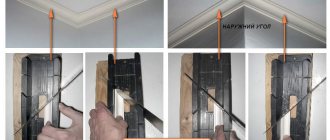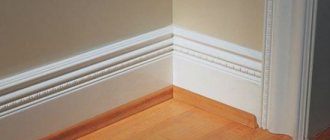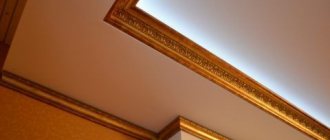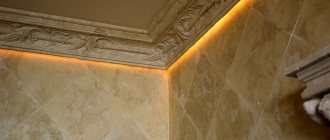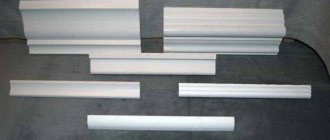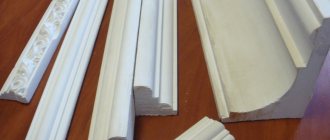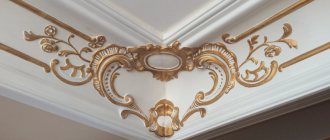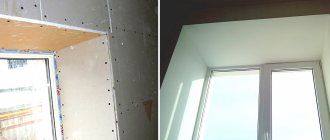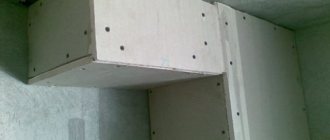When starting to renovate your living space, you choose in advance the type of ceiling design. The quality of finishing of the ceiling part depends not only on the materials used, but also on compliance with a certain technology. Having completed the main front of the work, bringing the ceiling surface into proper form, one more step will be required so that the overall picture inside the premises acquires finished shapes and outlines. We are talking about installing ceiling skirting boards. The fillets used today for such work can be very different, wide and narrow, with a regular profile or with complex terrain.
Products also differ in the material from which they are made, installation and scope of application. Let's consider in this article a ceiling molding made of polyurethane. How interesting is this technical solution for finishing ceilings and what are its main features?
Getting ready for installation
To ensure that the glued profile does not stand out from the overall finishing concept, but exclusively complements the design of the room, before gluing the ceiling plinth, you need to make the right choice of fillet.
Now the market is overflowing with different offers, ranging from simple foam planks to exclusive carved wooden models. But as practice shows, polystyrene foam, polyurethane and plastic profiles are in greatest demand for installation, both in standard apartments and in private houses. When the choice is determined, it is necessary to calculate how many rods will be needed for installation. To do this, you should calculate the perimeter of the room, do not forget about the ledges and niches. Divide the result by the length of the molding, round the uneven value up and add, to be on the safe side, another profile.
Tools for gluing skirting boards
What comes first
When the material is selected and calculated, the question inevitably arises: when to glue the baseboard, before covering the walls or after wallpapering? With the installation of plastic skirting boards, everything is logical; first they are attached to the wall, and only then PVC panels are inserted into the grooves of the profile.
Many people prefer to install ceiling plinths when the walls are already covered with wallpaper, this way they can cover unevenly cut edges. But if the surfaces have curvatures, then such installation of the plinth will highlight all the shortcomings of the room, cracks will be visible, and if, in addition, a flexible profile is glued, then it will fall in waves, spoiling the entire aesthetics of the interior.
Experienced craftsmen advise gluing the baseboard before finishing the walls, but trimming glued wallpaper evenly can be very difficult, so this installation method is the most difficult. If the surfaces are very curved, then you first need to level them, and only then stick the wallpaper, then install the baseboard. If the flaws are minor, then you should first install fillets, leveling the surfaces with putty, and only then finish the walls and stick wallpaper.
Watch the instructions on how to glue the ceiling plinth; the video explains in great detail how to cut the corner correctly.
https://youtube.com/watch?v=ygxDrxmA4kw
Glue
Adhesive for ceiling fillets is divided into polymer and acrylic according to its chemical composition. The choice of adhesive composition depends on the functional specifics of the room, for example, if the baseboard is installed in a nursery, then it is better to give preference to environmentally friendly acrylic, but for installation in a bathroom or on a loggia you will have to use polymer-based glue.
The basis of acrylic glue is water, so they are practically odorless, but they are completely unsuitable for installing skirting boards in rooms where humidity is high. Polymer samples are very durable and moisture-resistant, but they contain caustic solvents, so after installing the fillet, the specific smell of the glue will last about another month. For installing fillets with your own hands, instant-installation adhesive for ceiling plinths has proven itself well.
Also on the market for installing fillets are types of glue that sets quickly and even glues wet surfaces, which is extremely convenient, because working under the ceiling is a huge physical activity.
Advice: If you are going to stick wooden skirting boards, then glue alone will not do; you will additionally need nails or dowel-nails with self-tapping screws.
But craftsmen who decide to do the repairs themselves, by definition, are not looking for easy ways. Do this and it’s easy to mix the glue for installing skirting boards yourself. The fillet can be glued to the putty, and the cracks formed during installation can also be sealed with this solution.
To prepare the adhesive composition, you will need: 1 part water, a quarter part PVA glue, 1 part finishing putty. The glue components are thoroughly mixed until smooth, the mixture should stand for about an hour. Before attaching the ceiling plinth, the mixture must be mixed again.
https://youtube.com/watch?v=VxAUb3h4u08
Types of ceiling plinths
How to attach a suspended ceiling
Along with the question of choosing a decorative element, the question of what to glue the ceiling plinths to is no less pressing. The glue is selected depending on the type of baguette. The most common offers include:
- foam;
- expanded polystyrene;
- wooden;
- plaster.
A budget-friendly and easy-to-handle foam baseboard is chosen by most consumers. With all its advantages, few people think about the disadvantages at the time of purchase. The main one is fire hazard. When ignited, the baguette emits caustic smoke that is hazardous to health. Polystyrene foam is a short-lived and fragile material that requires careful handling to avoid breaks and dents.
In second place in cost is polystyrene foam plinth. With a slightly increased price comes increased strength. When cutting, the integrity of the canvas is not compromised. It is convenient to use, as it does not require additional painting and is easy to clean with water. When a fire occurs, it lights up as quickly as foam, but goes out after a short time.
Wood edging can be described as expensive, solid and luxurious. This is a plinth not for a year or two, but for decades. Installation of a wooden plinth is more difficult than the options listed above. If the wood is not varnished, it is difficult for the plinth to avoid deformation, rotting, and insect infestation, which significantly reduces its service life.
Gypsum stucco is chosen by wealthy people who try to emphasize the individuality of their home. Unique designer borders are created from environmentally friendly gypsum, distinguished by their durability in use.
Types of baguettes
Profiles for suspended ceilings differ in material, method of fastening and type of fixation of the canvas. Based on material, baguettes are divided into plastic and aluminum. They differ in characteristics and advantages.
The advantages of PVC baguettes include:
- flexibility, thanks to which the products fit tightly to uneven walls;
- low cost;
- lightness, reducing transportation costs;
- ease of installation (it’s easier to tighten screws, it’s not necessary to pre-drill);
- safety for the environment (will not damage new wallpaper or expensive furniture).
- fragility (10-15 years without replacing the canvas, and if you have to remove the film after 5-7 years, you will need a new baguette);
- fragility (withstands no more than 50 square meters of canvas);
- sometimes there is excessive softness, due to which the profile is deformed during installation (defects can be covered with a plinth, a plug will not work);
- increased rigidity is also a disadvantage: the baguette breaks in the corners, pieces break off from the front shelf during installation, so some of the elements have to be replaced;
- a large number of low quality products.
Advantages of an aluminum baguette:
- strength (does not deform, even on uneven walls it is easy to keep the frame level);
- the ability to install a suspended ceiling of any size;
- tight fit to the wall (combined with a masking insert);
- savings on fasteners (screws are screwed in less often);
- durability (even when replacing the canvas after 10-15 years).
But there are also disadvantages:
- high price;
- the difficulty of attaching to drywall (you have to drill the frame more often, which increases the total work time);
- difficulties when dismantling the canvas (the front shelf bends and the masking plug cannot be inserted back);
- conductivity of electric current (risk of injury during installation).
According to the method of fastening, baguettes are wall, ceiling and universal. The first option is used most often. The wall profile allows you to maintain different distances from the rough ceiling to the canvas. You can install built-in lighting, hide beams or communications running along the ceiling.
Ceiling profiles “eat up” the height of the room the least. But since they are attached directly to the floor slab, there is no way to adjust the level of the horizontal plane. Therefore, such a frame is placed only on a perfectly flat ceiling.
The universal profile is used for rooms with complex geometric shapes, built-in furniture and volumetric structures. Attaches to both walls and ceilings.
There are also types of frames depending on the system of fixation of the canvas. For PVC film, a harpoon or glazing bead (wedge) fastening is used; baguettes are produced in both plastic and aluminum. To stretch the fabric, only clip-on plastic profiles or glazing beads are used. Depending on the system of fastening the canvas, the design of the baguettes differs, but this does not affect the installation technology in any way.
Adhesive for polyurethane ceiling plinths
Corners for foam ceiling plinths
The advantage of polyurethane skirting boards is that this material itself is flexible, so it can be easily glued to ceilings with uneven surfaces, without fear of breakage or deformation of the product.
With the advent of polyurethane skirting boards, it became much easier to carry out repair work, because until that moment they used gypsum stucco molding, the installation of which was complex and time-consuming.
The best glue for this type of product is “Moment”.
Other polymer-based varieties are also suitable, and even liquid nails with various silicone-based sealants.
But their use is not so effective, because “Moment” dries quickly. and due to its excellent properties, the adhesion to the surface is more dense.
It is recommended to use it with a special sealant gun.
If you choose glue that dries less quickly, you will have to stand with your hands raised high, holding the baseboard for a long time, since polyurethane is heavy and can fall off.
This is not very convenient, because your hands will quickly get tired, and you won’t be able to press the product tightly to the surface.
Recommendations, in fact
It is important to remember that such consumables have significant weight, so it must be attached not only to the ceiling surface with glue, but also to the walls. Otherwise, the installed cornice strip may sag under its own weight.
For reference: polyurethane ceiling plinths should not be used to frame suspended ceilings.
In terms of cost, the material is much more expensive than plastic products and foam cornices, however, in the general context of finishing work, the total costs of installing polyurethane baguettes are relatively low. Today, consumables of this type are produced in a wide variety of sizes and shapes. Typically, when working with ceilings, skirting boards are used that imitate molding for rooms with a rich interior. A simpler and cheaper option is products with a flat surface in the form of a regular straight strip with a simple profile.
In the retail chain, polyurethane ceiling cornices are presented in products whose width can vary in the range of 5-20 cm. The surface of the cornices can be decorated with ornaments, and the lower edge of the products can have a figured appearance. The length of products is usually standard - 1.5; 2 and 2.5 meters.
Installation of such cornices will require some skill, especially when it comes to working with corners indoors.
Advantages and disadvantages of polyurethane skirting boards
Installation of ceiling plinth, photo and video instructions
As already mentioned, polyurethane plinth is the most durable and wear-resistant type of baguettes. In addition, let’s consider other positive features of the material:
- Flexibility. This ensures that the baguette can be attached to any surface, including uneven ones. At the same time, the quality of adhesion to the surface of the wall or ceiling remains the same.
- Polyurethane products are durable, while foam products simply break in places of slight pressure and deflection.
- Wear resistance. Manufacturers offer a 30-year warranty. During its entire service life, the baguette does not lose its visual appeal.
- Easy to use. It is free to process. It can be cut with an ordinary stationery knife.
The advantages always balance the disadvantages. If the seller didn’t tell you these, it means he’s being disingenuous:
- Unlike analogs made from other materials, this type of baguettes is heavier. Accordingly, in order to glue it to the wall, it is necessary to use special glue.
- The second, main disadvantage is the cost. The price of a polyurethane ceiling plinth is several times higher than that of a foam plinth.
If we compare the pros and cons of such material, then, without a doubt, the latter will pale in comparison with the positive characteristics of such baguettes
So why not pay closer attention to them?
Installation nuances
Preparation of materials
Before you begin installing ceiling plinths with your own hands, you need to do some preparatory work:
- first of all, you need to measure the walls, including areas with protrusions and recesses;
- then, in accordance with the obtained parameters, you need to apply markings to the planks;
- Next, the most difficult stage of work is performed - the planks are adjusted to the outer and inner corners. If the corners are right, they are cut at 45 degrees.
If there are deviations, the angle should be measured and the resulting value divided by two. The result will be the angle at which the fillets should be cut;
- if the profile is heavy, you should remove the wallpaper from the wall in the area where it will be adjacent. To do this, you need to attach the bar and draw a line along the lower border. After this, the wallpaper can be cut with a stationery knife.
This completes the preparatory work.
Gluing
The installation instructions for the ceiling profile are as follows:
- before applying glue to the ceiling plinth, you should treat the junction of the fillet with the wall and ceiling with a primer, which will improve adhesion;
- then an adhesive is applied to the back of the plank. If the fillets are narrow, then drops of glue should be left on the strip in increments of 5-10 cm. If the fillets are wide, then the composition is applied in a zigzag manner;
the processed plank is pressed against the wall and ceiling. It is best to start installation from the corners. The profile must be held in this position for some time until the composition sets;
- after pasting all the skirting boards, the joints need to be puttied, which will allow you to get one continuous decorative contour;
- At the end of the work, as a rule, paint is applied to the fillets, for example, acrylic water-dispersion. Before painting them, you should apply masking tape so as not to stain the walls.
Note! If the fillets are glued with Liquid Nails or other similar glue, after applying them to the wall it will not be possible to tear them off and re-glue them. Therefore, the work must be done carefully, since the price, for example, of polyurethane skirting boards is quite high
This completes the process of gluing the fillets.
Polymer adhesives are usually used to glue ceiling plinths, although sometimes it is better to replace them with putty. But, in any case, it is necessary to follow a certain gluing technology, which is given above.
Installation of interior baguette
According to the instructions given, you can do the installation of the interior molding yourself.
Do not forget that, unlike the usual ceiling cornice made of polystyrene, which is available in every hardware store, the interior molding already has a final finish that cannot be damaged during installation.
If you have started installation, then you have a ready-made design solution for where and what kind of baguette you will install; the picture above will help you.
Stages of installation of interior baguette
1. Before installing the baguette, clean the wall surface from dust, because the glue will not adhere normally to a dusty and dirty surface. It is optimal that the walls are leveled before installation, otherwise the money spent and the result of the installation will be negative and there will be a desire to redo everything and spend money again to do it better.
2. Determine the required lengths of the baguettes and cut the workpiece at the desired angle in accordance with the project using a miter box and a hacksaw. If necessary, sand the cut areas with fine sandpaper.
| Rice. 6. Miter box for cutting baguettes |
3. Apply mounting adhesive to the back of the baguette using a gun. Construction adhesive in plastic tubes and guns for them are sold in construction stores.
4. Press the baguette with the glue applied to the wall and hold it longer so that the glue sets a little; it is not recommended to let go immediately.
5. To join pieces of baguettes at the end, apply glue to one of the ends and squeeze the baguettes tightly. If the glue comes out, the excess can be removed with a damp cloth before it hardens.
6. If the joints have cracks, they can be sealed with soft furniture wax; it is sold in furniture hardware stores. Just choose the color you need. I do not recommend hard wax; it must be softened before use.
| Frame and interior baguette. Wooden, plastic and aluminum baguettes, read more. |
Why this material
Polyurethane has long earned the recognition of the inhabitants of our country.
It has a number of advantages compared to alternative options. Let's list the main ones: ease
Polyurethane skirting boards are characterized by minimal weight, which is especially important for installation on the ceiling; long service life. It is believed that products made from this material can reliably serve the owner of the premises for up to 30 years.
At the same time, they remain aesthetic and beautiful; resistance to external influences. Polyurethane structures are not afraid of high humidity and do not absorb aromas, so they can be used not only in bedrooms, but also in the kitchen; elementary installation. Polyurethane is distinguished by its softness and flexibility, which means it will not break or crack. In addition, minimal weight and adhesive fixation are also the most important advantages of this material; simplest care. For polyurethane there are no uncleanable contaminants. It does not require additional pest control treatment, unlike its wooden counterparts. You just have to pass a cloth over it from time to time, and your baseboard will look like new again and again; health safety. A ceiling plinth made of this material does not pose any threat to you and your family, unlike products made from the same plastic; variety of stylistic solutions. Products made from polyurethane will optimally fit into any interior. Using them, you don’t have to worry about them “falling out” from the overall style of the room.
As you can see, there are many obvious advantages of such a solution, and they could be listed for a very long time. But how are polyurethane products installed correctly? Next, we will analyze step-by-step instructions for quick but reliable fastening, and we will analyze all the main nuances of the procedure.
Choosing glue for ceiling plinth
Planning indoor renovation work is a complex process that requires special attention to detail. Ceiling plinth is a decorative element of the interior. Why do decorators and construction companies recommend gluing it?
In addition to its decorative function, the baguette masks repair defects. It is convenient to hide communications such as wires and cables behind it, which will reduce the time and costs of laying cable channels. Correctly selected edging can not only transform a room, but also visually enlarge or reduce it. Hiding the joints of the wallpaper and ceiling, the border gives the room a finished look.
How to choose a plinth
The interior dictates its own rules. The more expensive and exclusive the covering, the better its framing should be. To decorate the room with decorative details, designers recommend:
- The color can either match the shade of the flooring, walls, doors, or be a contrasting element. Computer programs with 3D visualization will help you choose the most appropriate design option.
- Wooden skirting boards are perfect for solid wood and laminate floors. Linoleum and carpet are combined with PVC planks. Ceramic products complement tile floors. Veneered and MDF skirting boards are universal and can be used with various types of floor coverings.
In order for the color of the baseboards to accurately “fit” into the color scheme of the room, painting is sometimes required. A fashionable option is white molding. It looks impressive, but requires support in the design with other details - platbands, fireplace portal, ceiling fillets.
Mounting process
It is necessary to understand that polyurethane ceiling plinth includes two subtypes: flexible and rigid. That is, it is a mistake to assume that any fillet option can be bent. Therefore, when finishing is carried out on different surfaces (curved, straight), it is necessary to consider the use of different skirting boards that will be combined with each other. This will save some of the budget for repair work.
When finishing surfaces of different curvature, it is better to combine an expensive flexible plinth with a cheaper straight version
To calculate the required number of parts, proceed from the general perimeter of the areas that need such finishing. That is, the resulting length is divided by the size of the elements.
The situation is a little more complicated with curved surfaces. But there is a simple way that allows you to take correct measurements. It is as follows:
- A cord is used for the process.
- The end of the rope is pressed against the beginning of the curved section.
- The cord is pulled so that it completely goes around the entire surface.
- The resulting segment is measured on a tape measure.
- + 10% is added to the result.
In this way, the flexible ceiling plinth is calculated most accurately.
Tools and Supplies
The following set of tools and materials is prepared for the work:
Simple pencil
It is important to keep in mind that if a felt-tip pen is used, all marks are made only on the reverse side. A stationery or construction knife - for cutting flexible fillets. A hacksaw and a miter box – for cutting hard baguettes. Glue for fixing elements. Construction gun and sealant in tubes to eliminate possible joints. If there is a subsequent decorative finishing, then you will need tools for such a process - paint, a brush... Tools and consumables necessary for installing polyurethane skirting boards
Tools and supplies needed to install polyurethane skirting boards
Installation steps
The first stage is preliminary preparation. It is necessary to perform a number of sequential actions:
- All areas are cleaned of dirt and dust. You should wipe the baguette, because it could have been stored for a long time, which led to its contamination.
- The walls and ceiling are treated with a primer. This rule applies only to those surfaces to which parts will be attached.
Primer treatment of areas to which the plinth will be attached
It is believed that it is best to install a polyurethane baseboard when wallpapering has not yet been done.
The second stage is that the markup is performed:
- One of the parts is pressed to the surface. Small marks are made on the sides - the step is ten to fifteen centimeters.
- All joints are marked separately.
Correct markings will help you trim the corners before installing the fragments. At the same time, in order to cut the polyurethane ceiling plinth of a rigid structure, a hacksaw is used
The element is installed in the miter box (it is important to correctly determine the cutting side) and is sawn according to the existing lines
Trimming fillet corners using a miter box
Now comes the third stage:
A tube of glue is prepared and installed in a construction gun. The composition is distributed evenly over the entire seamy side of the flexible element and pointwise over the surface of the rigid fillets. Installation begins from the selected angle. It's best to move in both directions
It is important to consider that the adhesive mixture is also applied to existing joints. Any excess that appears is immediately removed. After complete installation, the seams are coated with sealant and puttied.
Filling joints with sealant
Indeed, ceiling plinths made of polyurethane have a lot of positive properties and are not particularly difficult to fix. The main thing is to choose the right material, as well as follow the installation steps.
Preparation of tools and materials
To work you will need:
- ladder;
- laser level or hydraulic level;
- roulette;
- pencil;
- painting cord;
- hammer drill and drill with a diameter of 6 mm;
- screwdriver;
- hammer;
- hacksaw.
Before installation, you must purchase a sufficient amount of profile. For correct calculation proceed as follows:
- Determine the perimeter of the room in meters. In rectangular rooms, it is enough to measure the length and width, the result is added and multiplied by 2. For a more complex shape, you will have to measure all the walls.
- The resulting value is divided by 2.5 meters (the length of the standard profile) with rounding towards a larger number.
- Add 10-25% for margin for bends, cuts and installation errors. The more complex the configuration, the more it costs to add.
Now let's calculate the number of screws and dowels. The fastening step should be no more than 15 cm; for an aluminum profile it is permissible to increase the distance to 20 cm. Taking this into account, you can determine the required number of screws and dowels. It is also better to take fasteners with a reserve. You will need 5x40 mm self-tapping screws and 6x50 mm plastic dowels, as well as aluminum tape for processing the joints of the baguette.
Installation of polyurethane floor plinths
Next, we’ll look at how to attach a polyurethane floor plinth. It is also usually mounted with special glue. Gluing decorative skirting boards should begin from the corner of the room. The work is carried out in several stages:
- The surface of the walls and floor is being prepared for the baseboard. They must be thoroughly cleaned and degreased;
- The plank is coated with glue on the reverse side. There are special grooves (shelves) here. The composition must be applied specifically to them, as well as to the ends;
Glue is applied from the back side
- The floor plinth is pressed tightly against the wall and held there for several minutes. You can press it against the wall with something heavy;
- The joints between the planks are treated with acrylic sealant.
Tip: In places where the walls are uneven, the polyurethane floor plinth may come off slightly. In order for it to stick evenly over the entire surface, you just need to nail it down not all the way. After the glue sets, they can be pulled out. It is worth nailing the strips at the corners as well.
The wide polyurethane floor plinth looks very impressive in the interior. They glue it using the same technology. However, since it can shrink quite significantly, the joints between such high planks sometimes diverge after some time. In this case, you should wait until the gap stops growing, that is, the baseboard shrinks completely. After this, the old glue will need to be removed. Next, the split seam is filled with joint glue using a syringe. Since it forms a foam, care should be taken that it does not reach the surface by approximately 2mm when applying.
Wide floor polyurethane plinth looks very impressive, but is somewhat difficult to install
Polyurethane plinth can also be mounted mechanically using self-tapping screws. The video below shows this process step by step:
Painting the baseboard
White baseboards are often intended for painting. You can start painting it within a day after applying the sticker. How to paint polyurethane baseboard? For the ceiling version, water-dispersion paint is usually used. For flooring - acrylic or latex, since in this case the surface can be washed later.
To paint polyurethane floor plinths, you can use acrylic dye
We found out how to paint a polyurethane baseboard. Now let's see how best to do this. Typically, painting the baseboard is done before gluing it. However, it can be painted after installation. In this case, the walls and ceiling along the planks are glued with masking tape. Painting is done in two layers. You can use either a brush or a spray bottle.
Paint can be applied either with a spray gun or with a brush.
As you can see, flexible polyurethane floor plinth can be installed and painted, if necessary, independently, just like the ceiling one. The main thing is to ensure that it does not leave the surface.
Choosing the optimal ceiling plinth
Even before you start choosing what you can use to glue the ceiling plinth, you should understand what types of plinths are used most often and why. Often, the materials for making ceiling skirting boards are polyurethane and foam.
Despite the similarity of these samples and the presence of polymers in both materials, they have some differences:
- Polyurethane construction is more durable and flexible than foam construction. Of course, its cost is higher. Polyurethane tolerates conditions of high humidity well, so it can be installed in the kitchen or bathroom. The surface is less porous and more glossy.
To determine how much material needs to be used, you need to divide the size of the perimeter of the room being equipped by two (the length of one plinth element). As a result, you will get the required number of pieces.
How to properly glue ceiling plinths
To work you will need:
- good miter box,
- tracer,
- two spatulas - large and small,
- flat spatulas,
- glue gun,
- roulette,
- drywall knife,
- pencil,
- assembly adhesive,
- warm water.
The gluing of baseboards is carried out strictly after the completion of puttying of walls and ceilings.
EXCELLENT VIDEO INSTRUCTIONS
Let's get to work.
1. Cut a small piece from the baguette and apply it to the wall and ceiling, first stepping back slightly to the left of the corner, then to the right. Place marks with a pencil above and below the baguette. We carry out the procedure in all corners of the room. We connect these marks along all the walls using a tracer. This will help us glue the baguettes evenly.
2. Let's start trimming - you need to trim the baseboards into the inner corner at an angle of 45 degrees. To do this, turn the plinth upside down, place it on a miter box and saw off a piece at the desired angle. Then we take the second plinth, also turn it over and file it with a miter box in the other direction.
If you have to cut skirting boards into outer corners, proceed as follows:
- place the baguette against the corner, make a mark under the baguette using a drywall knife
- apply the second baguette to the other side of the corner and put a mark again,
- cut the plinths on the miter box according to the marks (don’t forget to turn them over).
It is also recommended to cut the next baguette, which will be adjacent to the first one, at an angle of 45 degrees. This way you will get a larger area for applying glue, and the parts will be connected more firmly.
We apply the baguettes to each other, making sure that the joint does not require modification.
3. We begin gluing. If the renovation is carried out in a bathroom with ceramic tiles, we apply special installation adhesive to the upper part of the baseboard and joints. We treat the lower part adjacent to the tile with silicone sealant (there should not be too much sealant, otherwise the excess will come out on the tile). We apply polystyrene foam glue to the back side of the baseboard.
4.Apply the plinth to the installation site. We remove excess glue with a spatula, and then carefully wipe it with a damp cloth until the composition dries.
If the resulting joint is not satisfactory, you can adjust the baseboards or cut them with a drywall knife.
5.The next day, apply gypsum putty with a spatula to the junction of the baseboards. This procedure must be repeated twice more after the composition has dried. The last time it is recommended to apply not gypsum, but acrylic putty.
We cut and glue the skirting boards on the ceiling
How to glue the corners of ceiling plinths
When work begins, the first question that arises is how to glue the skirting boards in the corners. Indeed, this is the most difficult moment; each element must be attached strictly at an angle of forty-five degrees.
To solve the problem, use a miter box. It has several slots, each of which has its own angle of inclination.
Place the plinth in the desired position, then carefully cut off part of it with a knife. Sand the cut area. Remember that the corner is cut out first and only then is it adjusted to fit the footage.
We glue the baseboards in the corners
VIDEO ON THE TOPIC
How to glue polyurethane skirting boards
Such fillets are made of durable and lightweight material. One of its main advantages of polyurethane is durability.
The polyurethane option can mask all joint defects. This material tolerates temperature changes, exposure to moisture and sunlight.
In addition, there is a wide range of colors and designs to choose from.
- Installation of polyurethane skirting boards is possible only on a clean and level surface, that is, the finishing of the ceiling and walls must be completely completed.
- To begin, prepare pieces of the required sizes and cut all the corners.
- Then proceed with installation. Polyurethane skirting boards are glued starting from the corner.
- On their reverse side there are grooves for glue. They need to be filled, and then press the baguette tightly against the wall.
- To complete the work, you can buy liquid glue or putty. There are no problems with polyurethane. Installation of other products may be difficult.
- It is better to make glue for foam baseboards yourself. To do this, you need to stir the finishing gypsum putty in water and add PVA glue.
- The finished composition is applied pointwise, after which the product is applied to the corner formed by the wall and ceiling.
VIDEO
Step-by-step instruction
Correct marking and cutting of baguettes
Before gluing baguettes to the ceiling, you need to calculate the required number of planks, so as not to later look for the missing ones or throw away the unused ones. The calculation is simple: calculate the perimeter of the room (the school curriculum for grade 2 will help you here). We divide the resulting number by 2, since this is the standard length of ceiling moldings. For defects and trimming corners we throw 2-3 strips. It should be remembered that in prominent places it is advisable to use solid strips of baguettes so as not to spoil the overall appearance with small pieces.
Now you know how to properly glue baguettes to the ceiling. But remember that the material must be cut correctly. To prevent the pancake from becoming lumpy and a good half of the materials ending up in the trash, it is better to use a special device for cutting baguettes - a miter box. With its help, you can make a corner joint almost perfect, because in ordinary apartments you rarely have perfectly smooth walls and ceilings.
You can cut baguettes evenly and accurately using a special device - a miter box.
No miter box - no problem. We offer step-by-step instructions for cutting baguettes without using a miter box:
- We apply the ceiling plinth to the corner on the left.
- Using a pencil, draw a line (10-12 cm) along the ceiling along the baguette.
- In the same way we make a 10 cm line in the corner on the right.
- The intersection of the lines is where the cut begins.
- On the left and right baguette we mark the intersection of the lines.
- From this mark to the opposite corner of the left and right strips, make an even cut with a knife at an angle of 45 degrees.
- We place the cut baguettes against the corner, checking the evenness of the joint.
How to glue baguette to the ceiling
You can glue the ceiling plinth using finishing putty or special glue.
Finishing putty
If you chose the first option, then the mixture must first be prepared. The procedure is simple: pour putty into a container with water and mix with a mixer. Some people add a little PVA glue to increase strength.
Then the mixture is applied to the edges of the baguette in an even layer using a spatula. The plinth is placed between the ceiling and the wall and pressed. Using a spatula and sponge, remove excess putty and cover cracks, irregularities, and joints.
Adhesive compositions
Most often, polymer adhesives such as “Titan”, “Moment”, or so-called liquid nails are used for gluing baguettes to the ceiling. The disadvantage of these compounds is that they smell unpleasant and are afraid of moisture. In order for the baguette with the applied adhesive to “grab”, you need to press it against the wall and ceiling for several minutes. The glue will hold the baguette securely for a long time, but it will not be possible to mask the joints, cracks and irregularities.
Sticking under a suspended ceiling
For many, the issue of gluing baguettes under a suspended ceiling causes fear and certain difficulties. But the wolf is not as scary as it is painted. The procedure has its own characteristics, which you will now get acquainted with.
The features of gluing baguettes under a suspended ceiling are as follows.
- Cutting should be done not under the ceiling, but on the floor, so as not to damage the film
- The baguette is glued only to the wall, so the adhesive solution is applied only to one side that is in contact with the wall
- A strip of paper is inserted into the gap between the baguette and the suspended ceiling, and then the baguette is painted.
Baguettes look natural under a suspended ceiling.
By adopting all the tips presented, you can easily solve the problem of how to glue baguettes to the ceiling without extra costs. Good luck with the renovation everyone!
Add your comment
How to restore a damaged area of polyurethane baseboard
Despite the high level of strength, this material can be damaged. For example, when rearranging furniture, you snag an element. The most common damage is a crack. It can be restored in two ways.
- Method 1. Cut out the damaged area or element entirely. We glue a new one in its place. But buying a new polyurethane baseboard can cost you money and ruin the overall appearance of your space, especially if the crack is small and only in one place. In this regard, we recommend using the second one.
- Method 2. Take a knife and widen the crack. Now remove the old glue. This can be done using a stationery knife or a metal file (hand only!). Fill the space with glue. That's it, now let it dry. After 24 hours, cut off the remaining glue. Sand the joint with fine sandpaper. We recommend taking zero or one. The voids can be filled with ordinary sealant, and the residues can be removed in the same way.
Installation of foam baseboard
Before installing skirting boards made of any material, it is necessary to thoroughly clean the surfaces of dust, dirt and oil stains. It is advisable to additionally treat them with an adhesive compound, which will increase adhesion.
Foam plinth for the ceiling is the most affordable and budget option to improve the joint between the walls and the ceiling, it is easy to maintain and easy to glue. If the walls are perfectly smooth, then such a fillet can be glued to acrylic sealant, squeezing out the glue pointwise every 150 mm. But our premises cannot boast of the correct geometry, therefore, in order for the installation of the ceiling plinth to be of high quality, without gaps, it is better to use a mixture of putty and PVA glue for fastening.
Laying skirting boards in a miter box for proper cutting of corners
You should start gluing the skirting boards from the corner. The question immediately arises: how to join and fasten the ceiling plinth? If you are sure that the corners are 90°, then it is recommended to use a miter box to cut the corners. But if the camber of the surfaces is plus or minus an elbow according to the map, then you will have to make markings on the ceiling. To do this, attach one plank to the installation site, make marks on the wall and ceiling, then, using a construction angle and a straight strip, draw 2 parallel lines along the entire perimeter of the room: one on the wall, the other on the ceiling.
How to properly glue ceiling plinths, photo of markings for cutting corners in uneven rooms
When the lines are drawn, first attach one profile to the installation site, mark the cutting points, markings are made in the same way on the perpendicular side. The points are connected by a straight line, along which the corner is cut with a knife or hacksaw.
The underside of the plinth is smeared with an adhesive solution; if it is putty, then the composition is applied with a spatula along the entire length, in a thin layer. The plinth is installed in place and carefully pressed. Once the baseboard is firmly attached, excess adhesive should be removed with a rubber spatula. The perpendicular strip is installed in a similar way.
How to attach skirting boards in corners
After gluing the corner elements, the plinth is installed along straight sections. Next, the joints and gaps are puttied. After the putty has dried, all irregularities are treated with fine sandpaper, and you can begin the final painting.
Idea: The product line of polyurethane skirting boards includes special decorative corner and joining elements for installation, which not only make joining the baguette easier, but also decorate the interior.
Work on installing polyurethane skirting boards
Polyurethane ceiling plinth has a wide range of applications. Finished products go well with ceramic tiles on walls and are used together with plastic panels. For plasterboard suspended systems, especially for multi-level ceilings, such fillets are a real “lifesaver”, allowing you to create ceiling surfaces of any curvature.
The methods for installing consumables have some differences from traditional technologies for installing ceiling plinths. As a rule, polymer-based adhesive is used for installation, which is applied to the edge of the profile adjacent to the wall and ceiling surface.
According to experts in the field of apartment design, the best means for installing polyurethane ceiling fillets is putty. In this situation, the ceiling, the cornice and the walls will be a solid structure, hiding all the defects and irregularities made during the installation process. When re-pasting wallpaper in a room, you will not have to dismantle the cornices.
Selection of materials
Before starting work on the ceiling with finishing, you need to decide on the amount of consumables, what kind of ceiling molding you choose and what shape.
The consumption is taken from the calculation: the perimeter of the room is divided by the length of one plank. For example: P/L, where:
P – Room perimeter;
L – Length of one baguette.
As a result, we get: 20 / 2 = 10 pcs. To equip ceilings in a room with a perimeter of 20 m, you will need 10 skirting boards 2 meters long. However, do not forget that spare parts may always be required. This means that you can add one more plinth to the result obtained, as a spare part. This will be the ideal amount of consumables needed for work.
Why do you need a supply of consumables? The thing is that when cutting corners, approximately 10 cm of product is consumed from each edge.
In addition to the above, care should be taken to handle materials. When transporting, try to avoid impacts on the material and intense bending. Before starting work, polyurethane consumables ready for installation should be left for a day in the room where the polyurethane ceiling plinth will be mounted and installed
This precaution is due to the fact that the material will restore its natural shape and adapt to the internal temperature conditions
There is one note: in finishing work, when working with polyurethane skirting boards, you should separate products according to the type of corners that are formed during the installation of the cornice. As a rule, finished products with angles of 30.45 and 60 degrees are available for sale. This gradation at the corners makes it possible to more accurately select finished products for installation at the junction of the walls and the ceiling surface. In addition, in addition to finished products, you can always purchase separate corner segments, thanks to which it is possible to obtain an ideal connection of baguettes at the joints.
Direct installation of baguettes on ceilings
After all the used fragments of the future cornice have been prepared and laid out on the floor around the perimeter of the room, it is time to begin installing them. To understand how to glue polyurethane ceiling plinths marked into fragments, follow traditional proven technology.
Laying of baguettes for finishing the ceiling is carried out only on dry and clean panels. Prepare the necessary tools and equipment in advance. You cannot do without a mounting knife, a hacksaw, a miter box, two types of glue, a spatula and fine-grained sandpaper.
Installation begins from the wall and from the corner located opposite the entrance to the room. On the reverse side of the products there are special grooves - shelves, for placing glue there. After applying the glue, the skirting boards are pressed to the installation site. Due to the quick drying of the glue, the adhesion of the mounted fragment to the walls occurs instantly. Having coated the end part of the installed element, we proceed to applying adhesives to a new piece of plinth. In this way, polyurethane ceiling plinths are laid around the entire perimeter of the room.
Particular attention should be paid to the installation of corners. When working with a miter box, be careful and do not apply too much force to the material.
The hacksaw cuts polyurethane baguette quite well and cleanly. Treat the cut at the sawing points with a mounting knife and fine sandpaper. In case you don't have a miter box on hand, use a template made according to the shape of the corners in your room.
Why is the material popular?
This is largely due to:
- Resistance to external factors and long service life: if you treat this type of skirting boards with care, it will retain its original appearance for at least 25-30 years. In addition, during its entire service life you will not see that the baseboard is susceptible to water/steam, and also does not absorb odor and is very convenient to clean. Such skirting boards are used in the bathroom, as they can withstand high humidity very well.
- Because it is not sensitive to temperature changes, which means it is perfect for rooms with many heating devices. Thanks to heating, it does not deform, retains its original shape and does not dry out.
- Convenience and ease of installation. The material is flexible and flexible, so installation does not require much effort, and you can do it even without outside help. You can also create protrusions and uneven planes, which complicate the work when it comes to simple baguettes. Fitting and cutting is easy and doesn't take much time.
- Installation does not require complex and expensive tools. A sharp knife will do just fine, and when you have secured everything, you can paint the baseboard with any paint - be it acrylic or water-based.
- Easy to care for. Cleaning in this case will be limited to washing only. Since this material is resistant to chemicals, polyurethane will not react with any detergents and will be cleaned without the risk of damaging color or texture.
- A huge selection is another plus. The market is rich in offers to fulfill any whim. These skirting boards differ from each other in texture, color, width and can complement any interior.
What are flexible fillets made of?
As we have already noted, for decorating the junction of the ceiling and wall in curved areas, a regular baseboard made of foamed polystyrene will not work - the material will crack or break even with the slightest attempt to bend it.
There are other ways to solve this problem, for example:
- the use of floor and ceiling PVC skirting boards, which become flexible when heated, which makes it possible to install them on curved areas;
- the use of “liquid plinth” - an innovative technology, the essence of which is the use of wood modified at the molecular level, placed in vacuum packaging;
- installation of veneered plinth made from cork chips, which gives it some plasticity.
It is worth noting that all of these options are most often used as an alternative, and the most popular material from which flexible ceiling skirting boards are made is polyurethane. It is thanks to its flexibility that it is possible to decorate curved areas with an arc of even a small radius.
Plastic polyurethane fillets are easy to install on any curves
Advantages of polyurethane skirting boards
It is worth noting that polyurethane includes a large group of polymers, and therefore can have different mechanical properties. In other words, the material may have the flexibility of soft rubber or, conversely, practically no different from hard plastic.
In any case, the advantages of polyurethane plinth include:
a wide color palette and assortment of textures - in addition to the fact that the material can be easily repainted in the desired color, there are products on sale that visually imitate various coatings, such as wood, stone, plaster, etc.;
Polyurethane fillets can be painted in any color
- long service life - polyurethane does not crack, break, or change its characteristics and properties;
- easy care - the material easily tolerates contact with water and various chemicals, so it can be washed with any cleaning agents;
- resistance to deformation - even under the influence of humidity, high or low temperatures, polyurethane retains its original shape;
- simple and quick installation - you can install flexible ceiling skirting boards yourself, even without any specialized knowledge in the field of repair.
Flexible decorative fillets – wood imitation
Ceiling polyurethane plinth: installation features
Repairs do not always bring the desired results. Especially when it comes to walls and ceilings. Most often, defects are visible in houses of old construction, appearing when wallpapering at the joints of the ceiling and walls. To remedy the situation, they came up with special products that form the basis of the finishing. One of them is polyurethane ceiling plinth. In addition to the fact that such elements hide defects, they also perform a decorative function, highlighting the stylistic direction of the interior, giving attractiveness and originality to the room.
How to choose a polyurethane baseboard, recommendations from the editors of Homius.ru
When choosing, you need to consider what type of room the plinth is selected for. For example, for a bathroom you should choose an option with a high moisture resistance threshold. Only environmentally friendly types are suitable for the kitchen and nursery. To do this, you should ask the seller for a certificate indicating the level of security.
In addition, you should rely on design. Here you may need baguettes with various ornaments. In some cases, smooth types can be used. There are painted and processed. That is, 100% ready for use.
We especially recommend taking into account the height of the ceiling. As stated above, baseboards can steal inches from your space. At the same time, with the right choice, you will gain additional centimeters.
Width
If you take the wide option for a room with a ceiling of 2.5 meters, then you will visually lose at least 10 centimeters. We recommend:
- for ceilings up to 2.5 meters, give preference to products no more than 4 cm wide;
- up to 3 meters, take a baguette, the width of which in the corridor is from 5 to 10 centimeters;
- For ceilings higher than 3 meters, moldings with a width exceeding 10 centimeters are used.
Form
Here the flight of imagination is unlimited. You can use both simple options and with a variety of ornaments. Including imitation stucco. In this case, we recommend following the basic law of the modern designer.
Same in style, but different in width
If the design of your room is too pretentious or you decided to combine several design ideas, then you should give preference to the classic version of baguettes. For a simple, no-frills design, we use fillets with ornaments. Try to give preference to types that will emphasize the exclusivity of the interior.
Color design
Manufacturers offer their clients various color solutions. On sale you can find baguettes with different shades. We recommend choosing a color that matches the decor style of your room.
Colored baguettes
There are some features to consider here. If the baguette matches the color scheme of the ceiling, then this will visually enlarge the space. If the shade matches the color of the wall, then you can easily raise the ceiling a few centimeters.
How to choose a baguette for the ceiling
How to glue foam ceiling plinth
Using various types of ceiling fillets, you can change the proportions of the room - visually enlarge or reduce it, subtract or add height, hide the LED strip, highlight the area where the chandelier is located.
In addition to its aesthetic function, the ceiling molding serves to implement practical solutions in the interior, hiding unevenness on the wall and flaws in decorative finishing.
Therefore, when choosing a cornice, you should be guided by the following criteria:
Width
If we talk about length, then the average value of this indicator for almost all types of baguettes is the same and is 2 meters. The width varies from 1 cm to 20 cm or more
When choosing a fillet, you need to pay attention to its width, since in some cases a massive molding can emphasize the sophistication and beauty of the renovation, in others, on the contrary, it can become its disadvantage:
- Wide baseboards smooth out corners well, rounding the room, which creates an atmosphere of comfort and tranquility.
- The width of the ceiling cornice allows you to hide defects on the walls and ceilings resulting from poor-quality joining of materials, etc.
- The greater the height of the room, the wider the ceiling molding should be purchased. The optimal ratio is presented in the table:
| Room height | Baguette width |
| Up to 2.5 m | Up to 40 mm |
| From 2.5 to 3 m | From 40 to 70 mm |
| More than 3 m | From 80 mm and above |
For very narrow and high rooms, it is recommended to decorate the ceilings with baguettes up to 70 mm wide and stucco moldings.
If the rooms are narrow and low, you should not rely on the width of the baseboard, but use it in conjunction with lighting. This will make the room softer and more comfortable.
Color
After choosing the material and width of the baguette, you should decide on its shade.
You can use classic white variations or bright explosive luminous decorative elements.
The main thing is to follow the following rules:
- White color visually elevates the space, so it is recommended to decorate the ceiling with a white fillet in a room whose height is less than 2.5 meters.
- Dark and wide baguettes, having the same color as the walls, will visually reduce the ceiling surface. These options are ideal to include in high rooms.
- White and black baseboards go well with any tone found in the decoration. However, you should not include too many main colors in the room; three shades are enough.
It is better that the decorative elements match the color of the ceiling surface, the tone of the walls, or have a bright contrasting shade.
Form
The last important criterion that you should definitely pay attention to when choosing ceiling plinths and baguettes for finishing is their shape. The main task is to decide the question: buy a regular baguette of the correct geometric shape or buy a plinth with complex images? In this case, a sense of proportion and natural taste will help.
It is important to understand that overly complex reliefs will look appropriate in a pompous interior that includes a large number of antique elements
In this case, a sense of proportion and natural taste will help.
It is important to understand that overly complex reliefs will look appropriate in a pompous interior that includes a large number of antique elements
On a note! The complexity of the work on adjusting the corners of the ceiling plinth directly depends on the nature of the pattern. The simpler the design, the fewer difficulties will arise during installation.
The simplicity of the shapes and lines on the ceiling molding will fit well into any interior, will not attract unnecessary attention, and will not visually change the volume of the room.
Advice! If a homogeneous smooth texture was used when finishing the walls and ceiling surface, you can use a plinth with a pronounced relief and complex ornament as a finishing element. On the contrary, the more unusual the texture on the walls and ceilings, the simpler the baguette should be.
The finishing fillet on the ceiling will help give the interior a finished and harmonious look. The low cost of this finishing element will visually change the appearance of the room. It is necessary to choose a product taking into account the characteristics of the design project or your own preferences.

